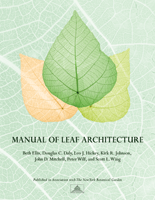New Book on Leaf ID Touted as Groundbreaker
Posted in Science, Shop/Book Reviews on May 20 2009, by Plant Talk
 |
Douglas Daly, Ph.D., is Director of the Institute of Systematic Botany and B.A. Krukoff Curator of Amazonian Botany. He is the co-author, along with Beth Ellis, Leo Hickey, Kirk Johnson, John Mitchell, Peer Wilf, and Scott Wing, of the newly released Manual of Leaf Architecture, published by NYBG Press. In this blog entry, Doug describes the invaluable information the book provides. |
Often we can distinguish two unrelated plants just from their leaves, even if the leaves are similar in size and shape, but how do we pinpoint those differences and put them into words? Similarly, foresters in the tropics need to be able to distinguish valuable timber trees from closely related tree species that may be endangered or have poor quality wood, but what characteristics can they use to detect those species? Other scientists who study the plants of the distant past need to be able not only to separate leaf fossils but also to quantify how many of the same species are found at a given site; how can they do that consistently?
 Until now, plant classification and identification have relied heavily on flowers and fruits, but these structures are not present most of the year. Moreover, fossil leaves are almost never found together with reproductive parts. Leaves display a wealth of characteristics that can be diagnostic at the level of genus or even species, but there wasn’t a logically ranked system that defined, described, and illustrated these characteristics. My co-authors and I wrote the Manual of Leaf Architecture precisely to provide an exhaustive, comprehensively illustrated reference for thoroughly describing the leaves of flowering plants, especially their vein patterns.
Until now, plant classification and identification have relied heavily on flowers and fruits, but these structures are not present most of the year. Moreover, fossil leaves are almost never found together with reproductive parts. Leaves display a wealth of characteristics that can be diagnostic at the level of genus or even species, but there wasn’t a logically ranked system that defined, described, and illustrated these characteristics. My co-authors and I wrote the Manual of Leaf Architecture precisely to provide an exhaustive, comprehensively illustrated reference for thoroughly describing the leaves of flowering plants, especially their vein patterns.
In our reasearch and writing we were able to draw fundamental conclusions about the evolution, ecology, diversity, and management of ecosystems and plant resources, based on identifications and characterizations that in turn are based on leaves. This reference puts all that work on a more secure footing.
Editor’s note: Manual of Leaf Architecture is receiving rave reviews. Lawren Sack of UCLA considers it a major contribution that will “revolutionize the study of leaves” and says it is “analogous to the first manual on human anatomy.” Sir Peter Crane of the University of Chicago calls it “indispensable” for researchers.

